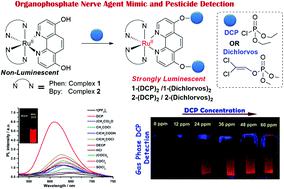当前位置:
X-MOL 学术
›
Inorg. Chem. Front.
›
论文详情
Our official English website, www.x-mol.net, welcomes your
feedback! (Note: you will need to create a separate account there.)
Bis-heteroleptic Ru(II) polypyridine complex-based luminescent probes for nerve agent simulant and organophosphate pesticide
Inorganic Chemistry Frontiers ( IF 6.1 ) Pub Date : 2020-11-13 , DOI: 10.1039/d0qi00997k Bhaskar Sen 1, 2, 3, 4, 5 , Monosh Rabha 1, 2, 3, 4, 5 , Sanjoy Kumar Sheet 1, 2, 3, 4, 5 , Debaprasad Koner 3, 4, 5, 6 , Nirmalendu Saha 3, 4, 5, 6 , Snehadrinarayan Khatua 1, 2, 3, 4, 5
Inorganic Chemistry Frontiers ( IF 6.1 ) Pub Date : 2020-11-13 , DOI: 10.1039/d0qi00997k Bhaskar Sen 1, 2, 3, 4, 5 , Monosh Rabha 1, 2, 3, 4, 5 , Sanjoy Kumar Sheet 1, 2, 3, 4, 5 , Debaprasad Koner 3, 4, 5, 6 , Nirmalendu Saha 3, 4, 5, 6 , Snehadrinarayan Khatua 1, 2, 3, 4, 5
Affiliation

|
Two bis-heteroleptic ruthenium(II) complexes, 1[PF6]2 and 2[PF6]2 of 4,7-dihydroxy-1,10-phenanthroline, have been developed for the highly selective ‘light-up’ detection of nerve agent simulant and organophosphate pesticide in aqueous solution. Both the complexes, 1[PF6]2 and 2[PF6]2, were fully characterized by spectroscopic means and single-crystal X-ray diffraction studies. Compounds 1[PF6]2 and 2[PF6]2 show a selective turn-on luminescence response in the presence of nerve agent stimulant DCP over other competitive nerve agent surrogates, acylating agents, HCl and pulmonary agent like phosgene. The detection of DCP was achieved via a nucleophilic attack of two hydroxyl groups of the 4,7-dihydroxy-1,10-phenanthroline ligand with DCP by forming bulkier phosphotriester and corresponding PL enhancement. The detection limit implies that 1[PF6]2 and 2[PF6]2 are able to detect DCP at the micromolar level. 1H NMR titration, 31P NMR and ESI-MS analysis collectively support the binding mechanism of phenolic hydroxyl groups of the ligand L with the P![[double bond, length as m-dash]](https://www.rsc.org/images/entities/char_e001.gif) O center of DCP. Triplet state TD-DFT calculations endorsed that the weak and strong red luminescence of 1 and 1-(DCP)2 originated from the non-emissive 3MC and emissive 3MLCT states, respectively. Also, probes 1[PF6]2 and 2[PF6]2 have been used for the highly selective luminescence detection of an organophosphate pesticide, dichlorvos, over the market available other organophosphorus pesticides (paraoxon–ethyl, parathion–ethyl, profenofos, and dimethoate). Furthermore, a test paper strip coated with complex 1 was fabricated to detect DCP in the vapor phase and dichlorvos in solution. Finally, probe 1 was successfully applied in biological studies to visualize DCP as well as dichlorvos in catfish brain tissue.
O center of DCP. Triplet state TD-DFT calculations endorsed that the weak and strong red luminescence of 1 and 1-(DCP)2 originated from the non-emissive 3MC and emissive 3MLCT states, respectively. Also, probes 1[PF6]2 and 2[PF6]2 have been used for the highly selective luminescence detection of an organophosphate pesticide, dichlorvos, over the market available other organophosphorus pesticides (paraoxon–ethyl, parathion–ethyl, profenofos, and dimethoate). Furthermore, a test paper strip coated with complex 1 was fabricated to detect DCP in the vapor phase and dichlorvos in solution. Finally, probe 1 was successfully applied in biological studies to visualize DCP as well as dichlorvos in catfish brain tissue.
中文翻译:

用于神经毒剂模拟物和有机磷酸酯农药的基于双杂合Ru(II)聚吡啶配合物的发光探针
已开发出两种双杂多钌(II)配合物,即4,7-二羟基-1,10-菲咯啉的1 [PF 6 ] 2和2 [PF 6 ] 2,用于高选择性“亮”检测。神经制剂模拟剂和有机磷酸酯农药的水溶液。配合物1 [PF 6 ] 2和2 [PF 6 ] 2均通过光谱学方法和单晶X射线衍射研究得到了充分表征。化合物1 [PF 6 ] 2和2 [PF 6 ] 2与其他竞争性神经制剂替代物,酰化剂,HCl和肺部药物(如光气)相比,在存在神经制剂刺激剂DCP时,显示出选择性的开启发光响应。DCP的检测达到经由通过形成笨重磷酸和相应的PL增强用DCP的4,7-二羟基-1,10-菲咯啉配位体的两个羟基基团的亲核攻击。检测极限意味着1 [PF 6 ] 2和2 [PF 6 ] 2能够检测微摩尔水平的DCP。1 H NMR滴定,31 P NMR和ESI-MS分析共同支持了配体酚羟基的结合机理L与![[双键,长度为m-破折号]](https://www.rsc.org/images/entities/char_e001.gif) DCP的P O中心。三重态TD-DFT计算表明1和1-(DCP)2的弱和强红色发光分别来自非发射3 MC和发射3 MLCT状态。同样,探针1 [PF 6 ] 2和2 [PF 6 ] 2也用于有机磷酸酯农药敌敌畏的高选择性发光检测,而市场上其他有机磷农药(对氧磷-乙基,对硫磷-乙基,丙溴磷,和乐果)。此外,涂有复合物1的试纸条可以检测气相中的DCP和溶液中的敌敌畏。最后,探针1已成功应用于生物学研究,以可视化DC鱼脑组织中的DCP和敌敌畏。
DCP的P O中心。三重态TD-DFT计算表明1和1-(DCP)2的弱和强红色发光分别来自非发射3 MC和发射3 MLCT状态。同样,探针1 [PF 6 ] 2和2 [PF 6 ] 2也用于有机磷酸酯农药敌敌畏的高选择性发光检测,而市场上其他有机磷农药(对氧磷-乙基,对硫磷-乙基,丙溴磷,和乐果)。此外,涂有复合物1的试纸条可以检测气相中的DCP和溶液中的敌敌畏。最后,探针1已成功应用于生物学研究,以可视化DC鱼脑组织中的DCP和敌敌畏。
更新日期:2020-12-17
![[double bond, length as m-dash]](https://www.rsc.org/images/entities/char_e001.gif) O center of DCP. Triplet state TD-DFT calculations endorsed that the weak and strong red luminescence of 1 and 1-(DCP)2 originated from the non-emissive 3MC and emissive 3MLCT states, respectively. Also, probes 1[PF6]2 and 2[PF6]2 have been used for the highly selective luminescence detection of an organophosphate pesticide, dichlorvos, over the market available other organophosphorus pesticides (paraoxon–ethyl, parathion–ethyl, profenofos, and dimethoate). Furthermore, a test paper strip coated with complex 1 was fabricated to detect DCP in the vapor phase and dichlorvos in solution. Finally, probe 1 was successfully applied in biological studies to visualize DCP as well as dichlorvos in catfish brain tissue.
O center of DCP. Triplet state TD-DFT calculations endorsed that the weak and strong red luminescence of 1 and 1-(DCP)2 originated from the non-emissive 3MC and emissive 3MLCT states, respectively. Also, probes 1[PF6]2 and 2[PF6]2 have been used for the highly selective luminescence detection of an organophosphate pesticide, dichlorvos, over the market available other organophosphorus pesticides (paraoxon–ethyl, parathion–ethyl, profenofos, and dimethoate). Furthermore, a test paper strip coated with complex 1 was fabricated to detect DCP in the vapor phase and dichlorvos in solution. Finally, probe 1 was successfully applied in biological studies to visualize DCP as well as dichlorvos in catfish brain tissue.
中文翻译:

用于神经毒剂模拟物和有机磷酸酯农药的基于双杂合Ru(II)聚吡啶配合物的发光探针
已开发出两种双杂多钌(II)配合物,即4,7-二羟基-1,10-菲咯啉的1 [PF 6 ] 2和2 [PF 6 ] 2,用于高选择性“亮”检测。神经制剂模拟剂和有机磷酸酯农药的水溶液。配合物1 [PF 6 ] 2和2 [PF 6 ] 2均通过光谱学方法和单晶X射线衍射研究得到了充分表征。化合物1 [PF 6 ] 2和2 [PF 6 ] 2与其他竞争性神经制剂替代物,酰化剂,HCl和肺部药物(如光气)相比,在存在神经制剂刺激剂DCP时,显示出选择性的开启发光响应。DCP的检测达到经由通过形成笨重磷酸和相应的PL增强用DCP的4,7-二羟基-1,10-菲咯啉配位体的两个羟基基团的亲核攻击。检测极限意味着1 [PF 6 ] 2和2 [PF 6 ] 2能够检测微摩尔水平的DCP。1 H NMR滴定,31 P NMR和ESI-MS分析共同支持了配体酚羟基的结合机理L与
![[双键,长度为m-破折号]](https://www.rsc.org/images/entities/char_e001.gif) DCP的P O中心。三重态TD-DFT计算表明1和1-(DCP)2的弱和强红色发光分别来自非发射3 MC和发射3 MLCT状态。同样,探针1 [PF 6 ] 2和2 [PF 6 ] 2也用于有机磷酸酯农药敌敌畏的高选择性发光检测,而市场上其他有机磷农药(对氧磷-乙基,对硫磷-乙基,丙溴磷,和乐果)。此外,涂有复合物1的试纸条可以检测气相中的DCP和溶液中的敌敌畏。最后,探针1已成功应用于生物学研究,以可视化DC鱼脑组织中的DCP和敌敌畏。
DCP的P O中心。三重态TD-DFT计算表明1和1-(DCP)2的弱和强红色发光分别来自非发射3 MC和发射3 MLCT状态。同样,探针1 [PF 6 ] 2和2 [PF 6 ] 2也用于有机磷酸酯农药敌敌畏的高选择性发光检测,而市场上其他有机磷农药(对氧磷-乙基,对硫磷-乙基,丙溴磷,和乐果)。此外,涂有复合物1的试纸条可以检测气相中的DCP和溶液中的敌敌畏。最后,探针1已成功应用于生物学研究,以可视化DC鱼脑组织中的DCP和敌敌畏。











































 京公网安备 11010802027423号
京公网安备 11010802027423号